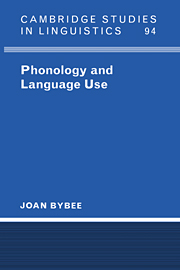Book contents
- Frontmatter
- Contents
- List of Figures
- List of Tables
- Acknowledgments
- 1 Language Use as Part of Linguistic Theory
- 2 A Usage-Based Model for Phonology and Morphology
- 3 The Nature of Lexical Representation
- 4 Phonological Processes, Phonological Patterns
- 5 The Interaction of Phonology with Morphology
- 6 The Units of Storage and Access: Morphemes, Words, and Phrases
- 7 Constructions as Processing Units: The Rise and Fall of French Liaison
- 8 Universals, Synchrony and Diachrony
- References
- Author Index
- Subject Index
- Languages Index
2 - A Usage-Based Model for Phonology and Morphology
Published online by Cambridge University Press: 03 December 2009
- Frontmatter
- Contents
- List of Figures
- List of Tables
- Acknowledgments
- 1 Language Use as Part of Linguistic Theory
- 2 A Usage-Based Model for Phonology and Morphology
- 3 The Nature of Lexical Representation
- 4 Phonological Processes, Phonological Patterns
- 5 The Interaction of Phonology with Morphology
- 6 The Units of Storage and Access: Morphemes, Words, and Phrases
- 7 Constructions as Processing Units: The Rise and Fall of French Liaison
- 8 Universals, Synchrony and Diachrony
- References
- Author Index
- Subject Index
- Languages Index
Summary
Introduction
The goal of phonology as conceived by generative theory is to describe the following phenomena: (i) the relations among similar but physically distinct sounds that are nonetheless taken to be ‘the same’ in some sense (allophonic relations), (ii) the relations among variants of morphemes as they occur in different contexts, (iii) phonological units of various sizes – features, segments, syllables, feet, and so on, and (iv) language-specific and universal properties of these relations and units.
Assuming that the proposed methods for accomplishing these goals in generative phonology are familiar to readers, I will briefly show in this chapter that an alternate model, which does not make the same assumptions as generative phonology, can accomplish these same goals as well as accommodate other facts about phonological structure that are left unexplained in generative theory. The evidence in favor of this model is not all presented here, but rather is developed in later chapters, since this chapter is intended to provide a frame of reference for proposals discussed later in the book.
The model sketched here is based on my proposals in Bybee (1985) concerning relationships among morphologically related forms – proposals that were derived from the study of the crosslinguistic properties of morphological systems and the characteristic ways in which morphological forms change over time. It is augmented by the theoretical statements contained in Langacker (1987, 2000) and other works. The model also incorporates findings on phonetic categorization reported by Miller (1994) and K. Johnson (1997) and on lexical relations reported by Pisoni et al. (1985).
- Type
- Chapter
- Information
- Phonology and Language Use , pp. 19 - 34Publisher: Cambridge University PressPrint publication year: 2001



